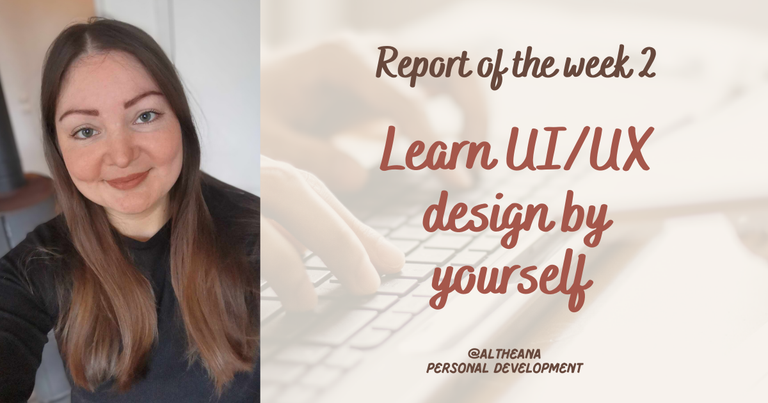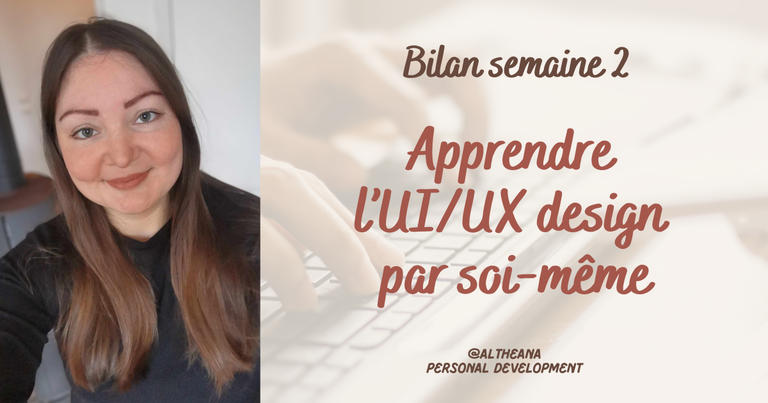
Hello friends! I hope you are all doing very well. 😁
As you know, this year, I decided to acquire knowledge in UI/UX design. And for that, I am following free courses that I find on the internet.
I started last week with a course on Design Thinking, which I had not completely finished. So I finished it this week.
As a reminder, last week, I learned the IDEO method, which is one of the most used methods in Design Thinking. It is composed of several phases:
- empathy (understanding needs),
- definition (development of a problem to solve),
- ideation (brainstorming to find the most suitable solution),
- prototyping,
- the testing phase.
And this week, in the last part of the introductory course, I learned how to apply this method to the professional world.
First of all, I discovered new tools to apply the Design Thinking method within a company or teamwork:
- The Google suite (Google Drive, Google Docs, Google Slides, ...) or Notion for the empathy, definition and ideation phases.
- Canva and Figma (which I already knew very well) for the prototyping phase as part of a website or mobile application project.
- Invision and Lookback to have other users test the project.
- Trello for monitoring the testing and prototyping phases.
I also watched a conference by Don Norman, the author of the book “The Design of Everyday Things”, who explained the importance of positive emotions in design. Positive emotions define what a good design is or not.
Indeed, if you have a bad experience with a website because you cannot easily find the information you are looking for, you will feel frustration and negative emotions. This means that you will no longer want to use it and that the design is therefore bad.
A good design contains quality and well-placed “signifiers”. Signifiers are those signs that indicate how to use a particular feature.
For example, on a website, the 3 lines correspond to the burger menu that unfolds, the arrows indicate that they allow you to change pages, etc. These are signs that everyone knows, which give clear information on how to use this feature.
When the signifiers are non-existent or poorly placed, the user may feel incomprehension, frustration or even annoyance. And this can even, in some extreme cases, be dangerous.
For example, on the doors of public places, there are often clear signifiers: push or pull. Without them, users are frustrated not to know how to open the door the first time and in the event of a crowd movement, this can be dangerous.
In short, taking into account the user experience is essential to create a good design, whether for everyday objects, or the interface of a mobile application or a website.
Week 2 review:
I only had time to finish the course on Design Thinking so I didn't make much progress. But the course was very interesting.
I think I could quite easily apply the IDEO method to my daily life. To go further, I think I'll read the book: "The Design of Everyday Things" by Don Norman, it's a subject that intrigues me.
My next course will be on the fundamentals of UX Design, I can't wait to discover it! 👍
See you soon,
Johanna
PS: I used Google Translate to translate the part into English.

Hello les amis ! J’espère que vous allez tous très bien. 😁
Comme vous le savez, cette année, j’ai décidé d’acquérir des connaissances en UI/UX design. Et pour cela, je suis des cours gratuits que je trouve sur internet.
J’ai commencé la semaine dernière avec un cours sur le Design Thinking, que je n’avais pas totalement terminé. Je l’ai donc terminé cette semaine.
Pour rappel, la semaine dernière, j’ai appris la méthode IDEO, qui est une des méthodes les plus utilisées en Design Thinking. Elle est composée de plusieurs phases :
- l’empathie (compréhension des besoins),
- la définition (élaboration d’une problématique à résoudre),
- l’idéation (brainstorming pour trouver la solution la plus adaptée),
- le prototypage,
- la phase de test.
Et cette semaine, dans la dernière partie du cours d’introduction, j’ai appris à appliquer cette méthode au monde professionnel.
Tout d’abord, j’ai découvert des nouveaux outils pour appliquer la méthode du Design Thinking au sein d’une entreprise ou d’un travail en équipe :
- La suite Google (Google Drive, Google Docs, Google Slides,...) ou Notion pour les phases d’empathie, de définition et d’idéation.
- Canva et Figma (que je connaissais déjà très bien) pour la phase de prototypage dans le cadre d’un projet de site web ou d’application mobile.
- Invision et Lookback pour faire tester le projet à d’autres utilisateurs.
- Trello pour le suivi des phases de test et de prototypage.
J’ai également regardé une conférence de Don Norman, l’auteur du livre “The Design of Everyday Things”, qui expliquait l’importance des émotions positives dans le design. Les émotions positives définissent ce qu’est un bon design ou pas.
En effet, si vous avez une mauvaise expérience avec un site internet parce que vous ne trouvez pas facilement l’information que vous recherchez, vous allez ressentir de la frustration et des émotions négatives. Cela veut dire que vous n’aurez plus envie de l’utiliser et que le design est par conséquent mauvais.
Un bon design contient des “signifiants” de qualité et bien placés. Les signifiants sont ces signes qui indiquent comment utiliser telle ou telle fonctionnalité.
Par exemple, sur un site internet, les 3 traits correspondent au menu burger qui se déroule, les flèches indiquent qu’elles permettent de changer de page, etc. Ce sont des signes que tout le monde connaît, qui donnent une information claire sur la manière d’utiliser cette fonctionnalité.
Lorsque les signifiants sont inexistants ou mal placés, l’utilisateur peut ressentir de l’incompréhension, de la frustration ou même de l’énervement. Et cela peut même, dans certains cas extrêmes, être dangereux.
Comme par exemple sur les portes des lieux publics, il y a souvent des signifiants clairs : poussez ou tirez. Sans eux, les utilisateurs sont frustrés de ne pas savoir comment ouvrir la porte du premier coup et en cas de mouvement de foule, cela peut être dangereux.
En bref, la prise en compte de l’expérience utilisateur est essentielle pour créer un bon design, que ce soit pour les objets du quotidien, ou l’interface d’une application mobile ou d’un site web.
Bilan semaine 2 :
J’ai seulement eu le temps de terminer le cours sur le Design Thinking alors je n’ai pas beaucoup avancé. Mais le cours était très intéressant.
Je pense que je pourrais assez facilement appliquer la méthode IDEO à mon quotidien. Pour aller plus loin, je pense lire le livre : “The Design of Everyday Things” de Don Norman, c’est un sujet qui m’intrigue.
Mon prochain cours portera sur les fondamentaux de l’UX Design, j’ai hâte de le découvrir ! 👍
À bientôt,
Johanna
PS : J’ai utilisé Google Traduction pour traduire la partie en anglais.
!HUG
Your post has been manually reviewed for curation by the Principality of Bastion.
Check the Trail of posts we voted
Principality of Bastion - Our Leit Motiv? Let's Grow Together.
Principality's site | Minava NFT Market | Discord | Our Twitch Channel
You may TRAIL this account if you like the curation we do, or join our discord to know more about what we do.
